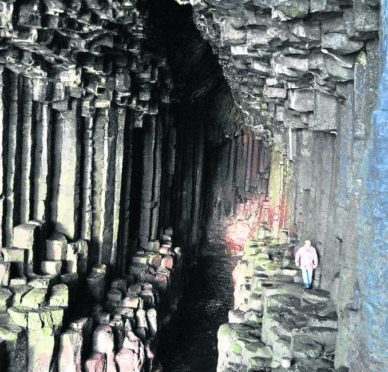It is an iconic destination that brings visitors from all around the world.
But Fingal’s Cave on Staffa – which inspired Mendelssohn to write one of the most famous classical works – has suffered storm damage that means fans will have to keep their distance for months.
The concrete walkway into the cave has been damaged by this winter’s violent storms, making it impossible to allow visitors into the cave on foot.
Instead, sightseers will only be able to view the spectacular cave from the entrance and from the sea.
Conservation charity the National Trust for Scotland (NTS) has issued assurances that fans will still be able to access Staffa, a National Nature Reserve with a puffin colony.
Staffa Ranger Emily Wilkins said: “This year’s winter storms have really taken their toll and the concrete walkway has been badly damaged. To keep our visitors safe, we are asking them not to enter the cave on foot, but to enjoy the views from the entrance or from boats.
“We are currently working with a team of engineers on possible solutions. Repairing a structure like this in such a remote location is a real challenge and realistically it will take several months before even a short term fix can be carried out.
“Staffa is still a fantastic place to visit, and we’ll be running our usual programme of summer events in the months ahead. Boat trips will continue as usual too.”
Six miles west of Mull, Staffa is only half and mile long and a quarter of a mile wide and formed of hexagonal columns that were created millions of years ago by volcanic eruptions and a vast blanket of lava that spread into the Atlantic Ocean.
Years of waves crashing against these columns created the dramatic feature that is Fingal’s Cave.
Staffa was hardly known until 1772, when the botanist Joseph Banks highlighted the wild, natural beauty of the island. It soon became a must-see location. Famous visitors have included Queen Victoria, Lord Tennyson, Jules Verne, Robert Louis Stevenson and John Keats.
The island came into the care of the National Trust for Scotland in 1986, a gift from John Elliott, Jr, of New York in honour of his wife Elly’s birthday and was designated a National Nature Reserve in 2001.
Mendelssohn’s concert overture The Hebrides, composed in 1830 and published in 1833, revised in 1832, is understood to have been inspired by Fingal’s Cave.
The German composer said he composed the opening theme of the work during an 1829 excursion to Staffa.
